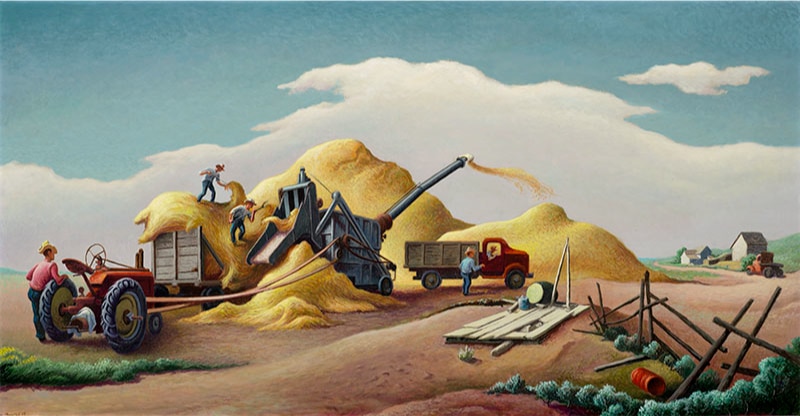Living in the American West
Background Information
The western part of North America offered many opportunities for Americans moving from the eastern regions of the United States. Although Native Americans, the Spanish, French, and Mexicans had called this area home for generations, Eastern settlers learned how to take advantage of the newly adopted territories. At first, exploration, fur trapping, and trade dominated life in the area. As more pioneers settled their families, farming and ranching became more prevalent, as did mining, once minerals were discovered. Although life in the West has changed a great deal, many of the industries that developed in the early days remain a major part of life today. Agriculture is one such industry.
Look Closer

The focus is on men working on the wheat harvest.
Observe how they interact with each other and the work they are doing.
Look around the scene, and notice what the farmers are surrounded by.
Artists have played a large role in reflecting the lives of people living in the American West, as well as shaping its image and economic development. Notice how this artist has captured a moment in time, capturing farmers at work on the high plains. Take a look at the scene depicted here. The focus is on men working on the wheat harvest1. Observe how they interact with each other and the work they are doing2. Look around the scene, and notice what the farmers are surrounded by3.
Discussion Questions
- How would you describe the way the artist depicted the individuals in the painting, and their interaction with each other?
- How has the artist depicted this livelihood? What is the relationship of the figures to their work in this painting?
- How has the artist depicted the scene? Consider the colors, the composition, and what the artist has included in the foreground and background.
- Can you tell what time period the artist was depicting in this work? How?
- What evidence of technology or innovation is present? What do you think the new technology might have replaced?
Activity
Farming and Ranching are still major industries in the American West, and have undergone major changes throughout the time that the United States expanded westward. Utilize the historic photos given for comparison, and research the history of the farming industry in this region. Using the worksheet, compare and contrast a scene in one of the photographs with what you see in this painting. How realistic are they?
Do you have familiarity with contemporary farming or ranching practices? If so, how does this painting compare to what you see today? Research and discuss the similarities and differences in small groups. How does this painting fit in? Is it realistic? Debate with your class.
Materials:
Compare & contrast worksheet
Historic photos
http://cdm16079.contentdm.oclc.org/cdm/singleitem/collection/p15330coll22/id/10690/rec/2
http://cdm16079.contentdm.oclc.org/cdm/singleitem/collection/p15330coll22/id/60992/rec/1
http://cdm16079.contentdm.oclc.org/cdm/singleitem/collection/p15330coll22/id/60985/rec/2
Image of Thomas Hart Benton’s painting
Grade levels: P-12 CO Standards
Visual Arts (2020)
Preschool: 1.1 ; 2.1 ; 4.1
Kindergarten: 1.1 ; 2.1 ; 3.1 ; 4.1
1st Grade: 1.1 ; 2.1 ; 3.1
2nd Grade: 1.1 ; 4.1
3rd Grade: 1.1 ; 2.1 ; 4.1
4th Grade: 1.1-2 ; 2.1 ; 4.1
5th Grade: 1.1-2 ; 2.1 ; 4.1
6th Grade: 1.1-3 ; 2.1-2 ; 4.1,3
7th Grade: 1.1-3 ; 2.1-2 ; 4.1-2
8th Grade: 1.1-3 ; 2.1-2 ; 4.1-3
High School: 1.1-2 ; 2.1-3 ; 4.1-3
Social Studies (2020)
Preschool: 1.1 ; 2.1 ; 3. 1; 4.1-2
Kindergarten: 1.1-2 ; 2.2 ; 3.1-2
1st Grade: 1.1-2 ; 2.1-2 ; 3.1 ; 4.1
2nd Grade: 1.1-2 ; 2.2 ; 3.1
3rd Grade: 1.1-2 ; 2.1-2 ; 3.1 ; 4.1
4th Grade: 1.1-2 ; 2.1-2 ; 3.1
5th Grade: 1.1 ; 2.1-2
6th Grade: 1.1-2 ; 2;1-2 ; 3.1
7th Grade: 1.1
8th Grade: 1.1-2 ; 2.1-2 ; 3.1
High School 1.1-3 ; 2.1-3 ; 3.1-4 ; 4.1
Reading, Writing and Communicating (2020)
Preschool: 1.1-2 ; 2.1 ; 3.1 ; 4.1
Kindergarten: 1.1-2 ; 2.2-3 ; 3.1-2,4 ; 4.1
1st Grade: 1.1-2 ; 2.2-3 ; 3.1-2,4 ; 4.1
2nd Grade: 1.1-2 ; 2.2-3 ; 3.1-2,4 ; 4.1
3rd Grade: 1.1-2 ; 2.123 ; 3.1 ; 4.1
4th Grade: 1.1-2 ; 2.2-3 ; 3.1-2,4 ; 4.1
5th Grade: 1.1-2 ; 2.2-3 ; 3.1-2,4 ; 4.1
6th Grade: 1.1-2 ; 2.2-3 ; 3.1-2,4 ; 4.1
7th Grade: 1.1-2 ; 2.2-3 ; 3.1-2,4 ; 4.1
8th Grade: 1.1-2 ; 2.2-3 ; 3.1-2,4 ; 4.1
9th/10th Grade: 1.1-2 ; 2.2-3 ; 3.1-2 ; 4.1
11th/12th Grade: 1.1-2 ; 2.2-3 ; 3.1-2 ; 4.1
Resources
http://lib.colostate.edu/research/agbib/project-background.html
http://www.loc.gov/teachers/classroommaterials/presentationsandactivities/presentations/timeline/riseind/west/
https://www.agclassroom.org/gan/timeline/
http://brt.uoregon.edu/cyberschool/history/ch16/16questions.pdf
http://plainshumanities.unl.edu/encyclopedia/doc/egp.ag.001



